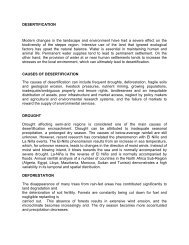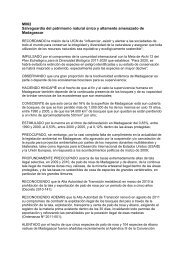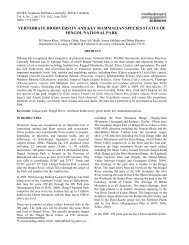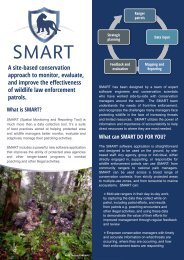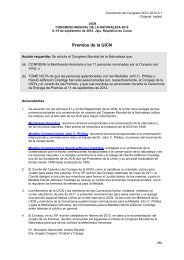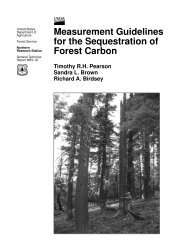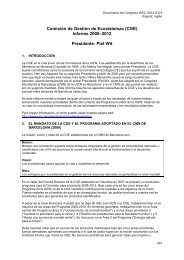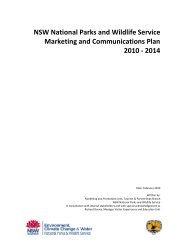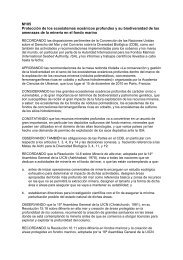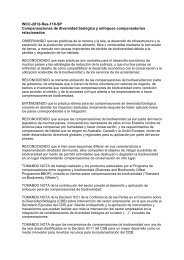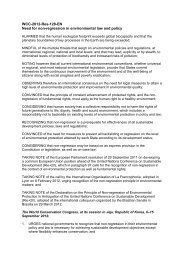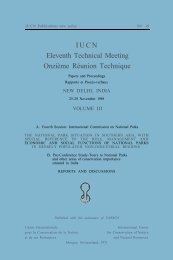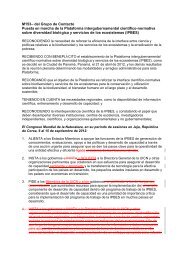Ecosystem- based approaches to adaptation in the Philippines ...
Ecosystem- based approaches to adaptation in the Philippines ...
Ecosystem- based approaches to adaptation in the Philippines ...
- No tags were found...
You also want an ePaper? Increase the reach of your titles
YUMPU automatically turns print PDFs into web optimized ePapers that Google loves.
<strong>Ecosystem</strong><strong>based</strong><strong>approaches</strong> <strong>to</strong><strong>adaptation</strong> <strong>in</strong><strong>the</strong>Philipp<strong>in</strong>es,South Africaand Brazil:Build<strong>in</strong>g <strong>the</strong>evidence baseEnrique A. Nunez Jr.Conservation InternationalPhilipp<strong>in</strong>esPho<strong>to</strong> 14.2” x 10.31”Positionx: 4.36”, y: .18”Pho<strong>to</strong> 25.51” x 10.31”Positionx: 8.53”, y: .18”
ecosystem <strong>based</strong><strong>approaches</strong> <strong>to</strong> <strong>adaptation</strong> forterrestrial, mar<strong>in</strong>e andcoastal regions• identify and implementecosystem-<strong>based</strong> <strong>adaptation</strong>activities <strong>in</strong> three diverse sett<strong>in</strong>gs(South Africa, Brazil, & Philipp<strong>in</strong>es)• <strong>in</strong>crease resilience andadaptive capacity of vulnerablepeople <strong>to</strong> climate changehttp://www.ch<strong>in</strong>apost.com.tw/news_images/20071129/wa.jpg
South Africa: Namakwaland Large communal area Arid Succulent Karoo veld Small, heavily utilisedseasonal wetlands andspr<strong>in</strong>gsClimate impacts: Hotter, drier, lesspredictableKey EbA activities: Veld res<strong>to</strong>ration Wetland res<strong>to</strong>ration Policy engagement
Brazil: Tropical forest/mar<strong>in</strong>e <strong>in</strong>terfaceThe Sou<strong>the</strong>rn Bahia/Abrolhos(SBA) region encompasses someof <strong>the</strong> threatened Atlantic forestand a biodiversity rich coral reefarea, coastal and <strong>in</strong>landcommunities whose livelihoodsstrongly depends on <strong>the</strong>seecosystems (fish<strong>in</strong>g, <strong>to</strong>urism,subsistence agriculture / cattleranch<strong>in</strong>g / forestry)32,000 km 2 of terrestrialecosystems and nearly 46,000km 2 of mar<strong>in</strong>e habitats thatsupport over 500,000 people.
Philipp<strong>in</strong>es: Verde Island PassageVerde Island PassageA Priority Mar<strong>in</strong>e Biodiversity Corridorof <strong>the</strong> Sulu-Sulawesi Seascape……and is part of <strong>the</strong> Coral Triangle
1.14 million ha. area (EO 578)5 prov<strong>in</strong>ces, 33 coastal municipalitiesEstimated 1.7 million people (coastal)A <strong>to</strong>p <strong>to</strong>urist dest<strong>in</strong>ationMajor fish<strong>in</strong>g ground
“Center of <strong>the</strong> Center” of Mar<strong>in</strong>e Biodiversity
Philipp<strong>in</strong>es’ IKI-EbA projectObjective 1: Secur<strong>in</strong>g <strong>the</strong> coastl<strong>in</strong>e and<strong>in</strong>crease coastal resilience <strong>to</strong> s<strong>to</strong>rmsurges, flood<strong>in</strong>g and erosion throughmangrove res<strong>to</strong>ration and protectionObjective 2: To build <strong>the</strong> resilience andadaptive capacity of fisheries andrelated livelihoods <strong>in</strong> <strong>the</strong> region
EbA <strong>in</strong> <strong>the</strong> Verde Island Passagebuilds on CI’s work on MPA and MPA networksestablishment; <strong>in</strong>clud<strong>in</strong>g establishment of Mangrove ForestConservation Areas <strong>in</strong> <strong>the</strong> Verde Island Passage Mar<strong>in</strong>eConservation Corridor .
Build<strong>in</strong>g <strong>the</strong> evidence base:Key project elements:1. Systematic vulnerabilityanalysis of people andecosystems2. Develop Theories of Change3. Ga<strong>the</strong>r socio-economicbasel<strong>in</strong>es <strong>in</strong> target communities4. Develop vulnerability <strong>in</strong>dex5. Evaluate cost-effectiveness6. Engage local, national and<strong>in</strong>ternational policy-makers
1) Vulnerability Assessment
ecologicalvulnerability• fish• coral• mangrove• seagrassVIP VA Elementshuman vulnerability• fisheries• <strong>to</strong>urism• foreshore dev’t• human health• food security
http://images.usa<strong>to</strong>day.com/wea<strong>the</strong>r/_pho<strong>to</strong>s/2006/12/10/twc-philipp<strong>in</strong>es.jpg
2) Theories of Change An approach <strong>to</strong> program plann<strong>in</strong>gand evaluation that maps <strong>the</strong>relationship between <strong>the</strong> long termgoal and <strong>the</strong> <strong>in</strong>termediate and earlychanges required <strong>to</strong> br<strong>in</strong>g it about Articulates how and why a programworks, with an emphasis on <strong>the</strong><strong>the</strong>ory underly<strong>in</strong>g <strong>the</strong> pathway fromactivities through <strong>to</strong> outcomes Uses evidence (both scientific andexperiential) <strong>to</strong> l<strong>in</strong>k <strong>in</strong>tendedoutcomes with activities be<strong>in</strong>gimplemented
Outcomes FrameworkThreatEbAResponseActivityOutputOutcome1Outcome2GOALCo-BenefitsBy 2025, X%<strong>in</strong>crease <strong>in</strong>cyclones[andassociateds<strong>to</strong>rm surge]Mangroveforestrehabilitationandres<strong>to</strong>rationMangroveplant<strong>in</strong>g# seedl<strong>in</strong>gsplanted perm2Rehabilitatedand res<strong>to</strong>redmangroveecosystemX% reduction<strong>in</strong> s<strong>to</strong>rmsurge overthat projectedBY 2025, X%marg<strong>in</strong>alreduction <strong>in</strong>loss ofcommunityassets <strong>to</strong>cyclonesCarbonFisheriesErosionNutrientcycl<strong>in</strong>g
3) Sett<strong>in</strong>g <strong>the</strong> basel<strong>in</strong>e• Socioecon moni<strong>to</strong>r<strong>in</strong>g tra<strong>in</strong><strong>in</strong>gdone us<strong>in</strong>g SOCMON-SEAmethodology• SocMon survey of householdspilot EbA sites
4) Develop vulnerability <strong>in</strong>dex
5) Cost effectivenessCost-effectiveness analysis is aform of economic analysis used <strong>to</strong>compare <strong>the</strong> relative costs andoutcomes (effects) of two or morecourses of action. CEA is often used<strong>to</strong> estimate <strong>in</strong>puts <strong>in</strong> monetaryterms and outcomes <strong>in</strong> nonmonetaryquantitative terms (suchas improvements <strong>in</strong> environmentaloutcomes). This is suitable <strong>in</strong>assess<strong>in</strong>g whe<strong>the</strong>r <strong>the</strong> outcome isreached at m<strong>in</strong>imum cost.
6) Engage policy makers; build<strong>in</strong>g partnershipsand stakeholder supportNationalAgencies• Department of Environment &Natural Resources• Department of Agriculture-Bureau of Fisheries & AquaticResources• National Climate ChangeCommission• NGO(NFR etc) and academepartnersLocal Government andCommunity groups• prov<strong>in</strong>cial officials• Municipal and village leaders• MPA and Enforcement Networks• Local NGOs, academe, o<strong>the</strong>rpartners• Village leaders and communitymembers
Engag<strong>in</strong>g stakeholders <strong>to</strong> betterunderstand ecosystems services andclimate change impacts <strong>in</strong> <strong>the</strong> VIP
Capacity build<strong>in</strong>g on:• Coastal Resource Management• Mangrove Management• Enforcement• MPA ManagementEffectiveness• Livelihoods and <strong>in</strong>comediversification
Key challenges/evidence gaps1) Quantify<strong>in</strong>g <strong>the</strong> <strong>adaptation</strong> service – just how much can e.g.mangrove res<strong>to</strong>ration reduce vulnerability?2) Is <strong>the</strong> <strong>adaptation</strong> <strong>in</strong>itiative susta<strong>in</strong>able under global change?3) How do you project expected project benefits of <strong>the</strong> <strong>adaptation</strong><strong>in</strong>itiative beyond <strong>the</strong> project lifetime?4) How do you go about robustly valu<strong>in</strong>g <strong>the</strong> <strong>adaptation</strong> serviceand co-benefits?5) What <strong>in</strong>stitutions and policies, at what scales, are needed <strong>to</strong>ensure successful EbA?6) How will <strong>the</strong> EbA <strong>in</strong>itiative be susta<strong>in</strong>ed by LGUs andcommunities? Governance issues, politics, land tenure issues.7) Understand<strong>in</strong>g <strong>the</strong> broader vulnerability/<strong>adaptation</strong> context – noproject can address all vulnerabilities
Robust M&E is critical Assess<strong>in</strong>g effectiveness Understand<strong>in</strong>g contexts and needs Track<strong>in</strong>g underly<strong>in</strong>g assumptions Ga<strong>the</strong>r<strong>in</strong>g and shar<strong>in</strong>g <strong>in</strong>formation Enabl<strong>in</strong>g adaptive management Meet<strong>in</strong>g transparency and report<strong>in</strong>grequirements
Take home messages
Thank You!



